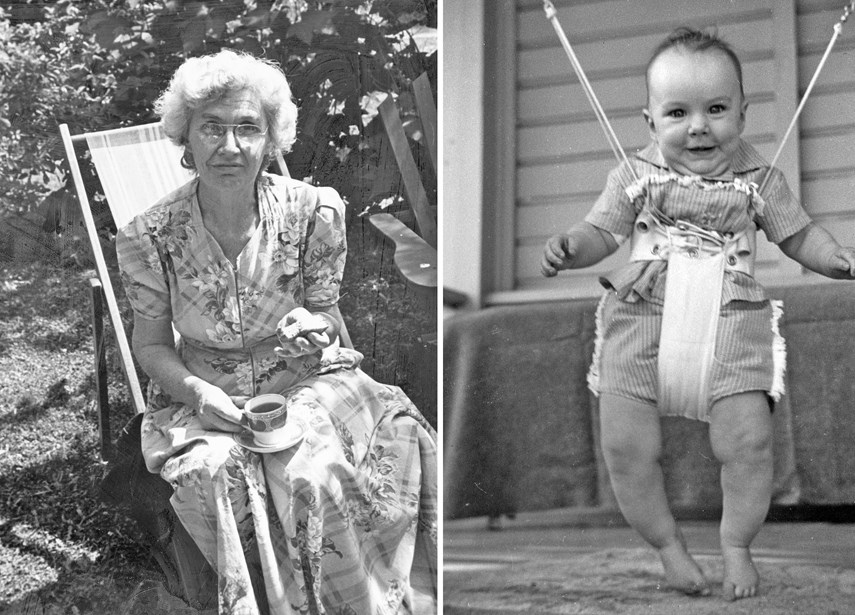9 Olivia Poole: Inventor of the Jolly Jumper
Amy Minervini

[The Flesch-Kincaid Grade Level is: 11.5]
Olivia Poole (nee Susan Olivia Davis) was born in 1889 and grew up on the White Earth Indian Reservation in Minnesota. She was part Ojibwe and experienced firsthand many of the customs and traditions of the Indigenous people. She would watch as the women would strap their babies in cradleboards, which the Ojibwe people called dikinaagan:
“While working in the fields, Poole observed, mothers would often hang their [dikinaagan] on a tree branch from long, sturdy, leather straps and give the branch a slight tug to produce a soft bouncing motion. The babies enjoyed this very much; often it soothed them and helped curb fussing and crying” (Massachusetts Institute of Technology).
Olivia went on to study music at Brandon College in Manitoba, Canada, for she was an accomplished pianist. In Manitoba, she met her husband Delbert, and they eventually had seven children together. It was after the birth of her first child that she remembered the clever bouncing papoose contraption the Ojibwe mothers created so that they could work with less interruption.
Although she did not have a cradleboard of her own, she decided to use things around the house to build something similar:
“She sewed a cloth diaper into a harness and created a brace with an axe handle. This device was different than a cradleboard, as the baby’s legs dangled freely and there was no rectangular board attached. Eventually, she added a spring and rubber connection so that the baby could bounce on its own. Her swing was low enough for the baby’s toes to reach the ground, allowing the baby to exercise its leg muscles” (Young).
She called it the Jolly Jumper and used it with all seven of her children and her grandchildren, refining it along the way. In the 1950s, her invention was mass produced by the family business, Poole Manufacturing, Co. Olivia formally patented her invention in 1957. Her device was indeed a game changer: “A Toronto Star article from July 1962 reported that Caroline Kennedy, the daughter of then-US President John F. Kennedy, was photographed in the jumper and referred to the jumper as a “lifesaver” for mothers” (Young).
Although Poole died in 1975, her Jolly Jumpers are a popular baby item with sales still going strong today!

Writing Prompts
Narrative: Recall a time when you were asked to babysit (sibling, cousin, neighbor, or even a pet). Share a story about this experience. What went well? What could have gone better? How did you keep this child or pet entertained? Using sensory language, be as detailed as you can in your descriptions about this adventure in babysitting. CCSS.ELA-LITERACY.W.6.3
Persuasive: Some think the baby jump device is excellent for exercise and a baby (or toddler) entertaining themselves. Others think the baby jump device can be hard on the baby’s hips and thighs. Argue whether the baby jumpers are safe or not, giving at least 2 reasons and examples as evidence. Please cite any sources you use. CCSS.ELA-LITERACY.WHST.6-8.1
Works Cited
Bengston, Ben. “NVMA 14771.” Photograph. North Shore News, North Vancouver Museum and Archives, 18 Apr. 2021, www.nsnews.com/in-the-community/time-traveller-heres-how-the-jolly-jumper-was-invented-in-north-vancouver-3640045. Accessed 3 Aug. 2022.
Massachusetts Institute of Technology. “Olivia Poole.” A National Leader in Advancing Invention Education | Lemelson, lemelson.mit.edu/resources/olivia-poole. Accessed 3 Aug. 2022.
Young, Jessica. “Olivia Poole.” The Canadian Encyclopedia, 24 July 2020, thecanadianencyclopedia.ca/en/article/olivia-poole. Accessed 3 Aug. 2022.
A board or frame on which an infant is secured, as by binding or wrapping in a blanket, used by certain Native American peoples as a portable cradle and for carrying an infant on the back

